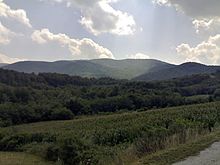

Pocerina is an area in the western part of Serbia, occupying lowland and lowland terrain on the northern side of the Cer mountain. It extends to Macva and Posavina. Pocerina was named after Mount Cer, the northernmost island mountain on the southern edge of the Pannonian Basin. Pocerina is located north of the mountain Cer. The area of Pocerina is 315 km². Two rivers flow through Pocerina: Dumača and Dobrava. Pits and sinkholes (Cerova jaruga on the border of the villages of Slatina and Bojića) appear in the limestone parts of Pocerina.
History[edit]
Prehistory[edit]
On the locality Šančina in the village Desić the "Serbian Stonehenge", dating back to the Copper Age (circa 4000 - 4300. BC) was discovered. The most significant discovery is the well, in the very center of the roundel, 6.3 m deep. There are theories that it was used for tracking celestial bodies, but also that shamans performed religious rites in this locality.
It is established that Gornja Vranjska, and this entire area, was also inhabited in the Neolithic era; for the Paleolithic and Mesolithic, it could not be proven for sure. First settlements in Gornja Vranjska existed in 3600 BC at Podrumine and Jusupovac.[1]
See also[edit]
References[edit]
- ^ , history
44°36′01″N 19°37′36″E / 44.6003°N 19.6267°E

Well, that’s interesting to know that Psilotum nudum are known as whisk ferns. Psilotum nudum is the commoner species of the two. While the P. flaccidum is a rare species and is found in the tropical islands. Both the species are usually epiphytic in habit and grow upon tree ferns. These species may also be terrestrial and grow in humus or in the crevices of the rocks.
View the detailed Guide of Psilotum nudum: Detailed Study Of Psilotum Nudum (Whisk Fern), Classification, Anatomy, Reproduction